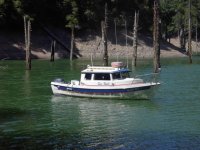There are two topics running about VHF antennas. One is about quality, the other location. Hope no one minds if I comment. I learn a lot here about boats but I can't add knowledge to this forum about crossing a bar at ebb tide or how to land a tuna but I've got some background in engineering that might help someone.
Quality does matter. It comes in two forms. The first is the engineering of the antenna, its design. Secondly is the construction of the antenna.
A good design should pay attention to feedline decoupling, material losses, radiation resistance, bandwidth, radiation pattern, desired application, etc. An antenna is a type of electrical circuit, a transducer, composed of the usual circuit elements; resistors, caps, inductors. Some are there by design, some aren't. They're not all discrete but they're there. The ones not there by design cost you. I know you don't want, as a purchaser, to get into all this but I mention it to show you that antennas are actually quite complex. Some of the nastiest math out there is used in antenna design and testing. Companies pass this engineering cost on to the customer.
Good construction means not only it's mechanical strength, stability, resistance to corrosion, etc. but also how much RF current and resulting power is wasted in heating a loading coil (steel vs copper), warming corrosion in a cheap connector or badly built or installed connectors, lossy dielectric materials, etc. These materials and manufacturing costs are...yep, passed on to the customer.
Remember that the field strength that your radio generates at a distant radio's antenna terminals is directly proportional to the current flowing in your antenna. The RF voltage should appear across the feedpoint and not be dropped by an unwanted circuit element. The most current will flow when the antenna is resonant. That is when voltage and current are in phase and when transmitter power is converted to radiation. That radiation appears as a standing wave of voltage and current maxima and minima across the length of the antenna. The antenna feedpoints should appear purely resistive and no power wasted in heat or dielectric losses. And very importantly, the antenna should do the radiating not the coax feedline. Many things conspire to affect that feedpoint impedance and maximum power transfer.
Another issue is how much the radiation pattern is distorted by the antenna coupling into a nearfield conductor; the boats standing rigging, radar arch, other antennas, or even a "rocket launcher". Location can matter. Two antennas (or antenna plus a metal object) too close together will couple, altering the feedpoint impedance, and distorting the radiated pattern. A typical 8 foot marine antenna is composed of two 5/8 wave antennas stacked colinearly with decoupling stubs. While the rule of thumb is maybe five wavelengths of separation you can't do that on a C-Dory but I'd definitely not put two 8 footers anywhere near each other. They are going to like each other a lot and will try and couple.
The change of a foot in height should make zero effective difference but if that foot is decoupling your antenna from some object and changing the shape of a lobe, well then maybe. Now a thirty foot mast, that will matter. I know there are simple formulas for calculating distance (and not so simple ones too) but I'd worry about the things mentioned above first.
A well designed, well made, carefully installed antenna will give better and more consistent results than a big, expensive, but perhaps poorly designed and made one that makes a better dummy load than an antenna. Price and company name can't always indicate performance.

